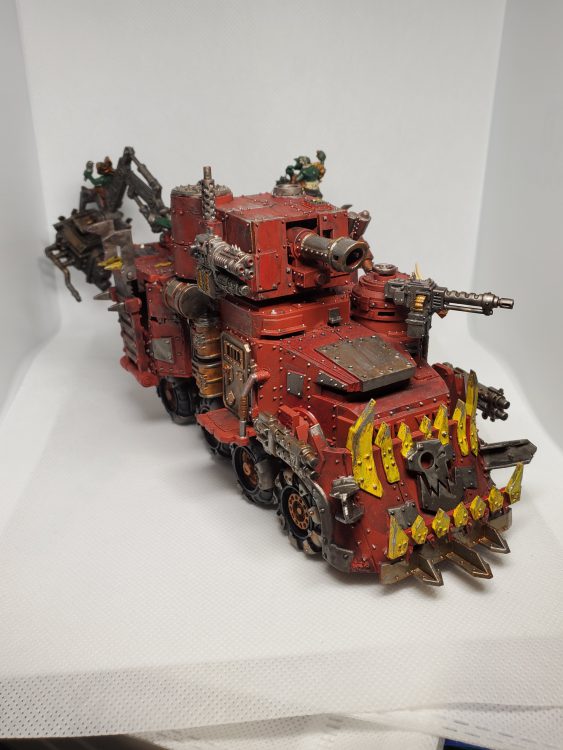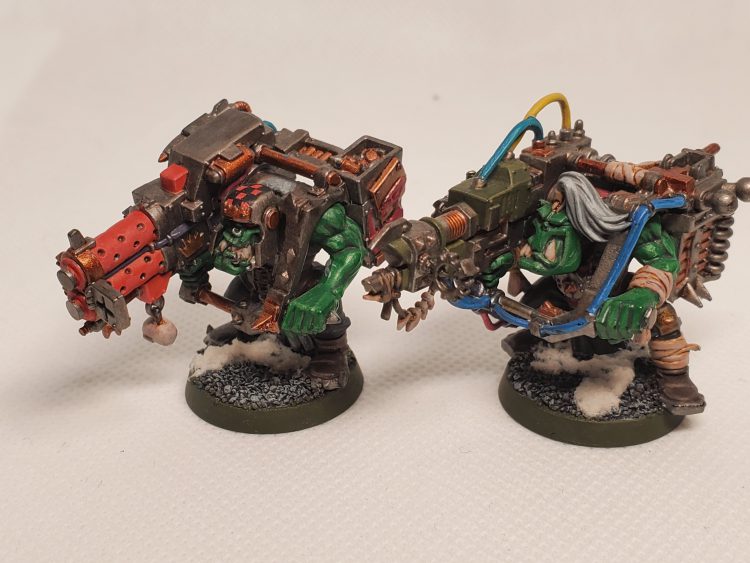In our How to Paint Everything series, we take a look at different armies of the Warhammer universe, examine their history and heraldry, and look at several different methods for painting them. Today we are looking at how to paint Orks, the green-skinned menace of the 41st millennium. Note that, while we will be doing a future piece on Orruks in Age of Sigmar, today’s piece focuses on the 40k variant, though many of these techniques (including Brin’s notes on painting green skin) will easily carry over to AoS.
Who Are the Orks?
The classic antagonists of the Warhammer 40,000 universe, the Orks are a race of violent, savage, green-skinned humanoids that have spread across the galaxy. They are brutish and warlike, focused entirely on fighting. Imagine a race of spacefaring football hooligans and you’re halfway there, basically.
At their core, Orks are essentially a sentient fungus, birthed from spores, and originally bio-engineered by the Old Ones (whom they refer to as “Brain Boyz”) to fight against the Necrons and the C’tan during the War in Heaven. Orks (called the “Krork” originally) aren’t really psychically gifted individually, but each ork emanates a latent psychic power that swells and grows when many orks are gathered together. Those orks who are particularly gifted (or more accurately, cursed) with an attunement to the warp – the Weirdboyz – act as lightning rods for this energy, channeling it and discharging it with deadly results.
As a product of the War in Heaven, the Orks predate humanity’s evolution by nearly 60 million years. Because of their hardiness, ability to endure pain and thrive in almost any climate, and their ferocity, they’ve spread across the galaxy, and been a threat to human expansion at every turn.
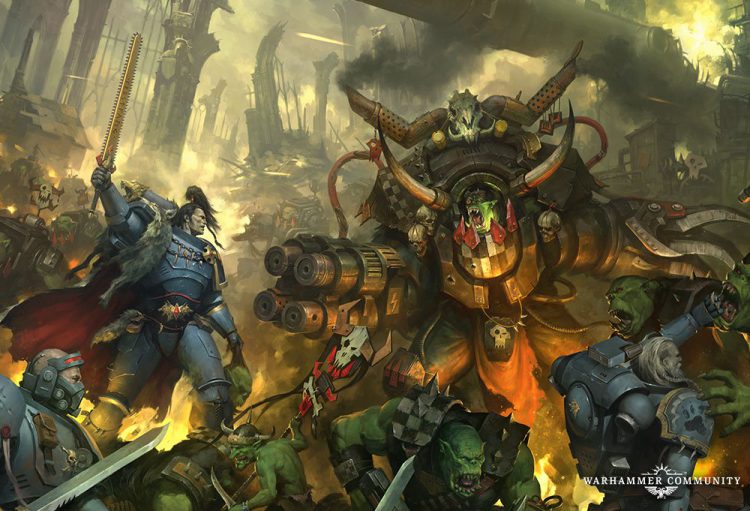
Ork society is generally split into tribes or clans called Kulturs.
- The Goffs are generally the biggest and meanest of the Orks. They’re the most warlike of an already warlike race, and they’re led by Ghazghkull Thraka, the largest, most dangerous Ork in the galaxy.
- The Bad Moons are the wealthiest Orks, owing mostly to the fact that they grow teef (Ork currency) faster than other Orks. Their displays of wealth mostly manifest as showing off larger guns and flashier, more developed equipment. They’re the shootiest of the Orks.
- Evil Sunz are almost exclusively members of a Kult of Speed, insane groups dedicated to the rush and thrill of going fast. They paint their vehicles red – which they believe makes them go faster – and ride them into battle in large massed fleets.
- Deathskulls are looters and magpies, stealing anything that isn’t nailed down and using it for their own gain. While Orks believe red vehicles go faster, they also believe that blue things are lucky. And so the Deathskulls paint themselves blue.
- Blood Axes are the skilled tacticians of the Ork race, opting for careful planning and coordinated tactics. They lay ambushes and traps, sneak up on or outflank enemies, and may even sometimes work as mercenaries.
- Freebooterz are clanless vagabonds who wander the stars, either cast out or left behind by their former clans. Now they hire their services out to the highest bidders and work with other clans.
- Snakebites are basically feral Orks, who believe in “Da Old Ways,” or how things were done before the Imperium and technology made everyone soft. They’re among the hardiest orks in the galaxy.
Orks don’t have a central leader or government resembling any human notion of the word but instead will organize en masse around powerful leaders in a massive battle group called a Waaagh! A Waaagh! will then move across the galaxy, razing planets and systems, until it is stopped by the enemy or until the Orks in it become bored and find something else to do.
Right now the most powerful Ork warboss is Ghazghkull Mag Uruk Thraka, the self-proclaimed Prophet of the Waaagh! and perhaps the most notorious warlord in the 40k setting. He leads the largest Ork Waaagh! ever assembled, was responsible for both the 2nd and 3rd Armageddon Wars, and just received a sweet new model. Ghazghkull’s exploits have recently seen his orks sweeping causing trouble galaxy-wide in Psychic Awakening VI: Saga of the Beast, though the warboss himself was suspiciously absent.
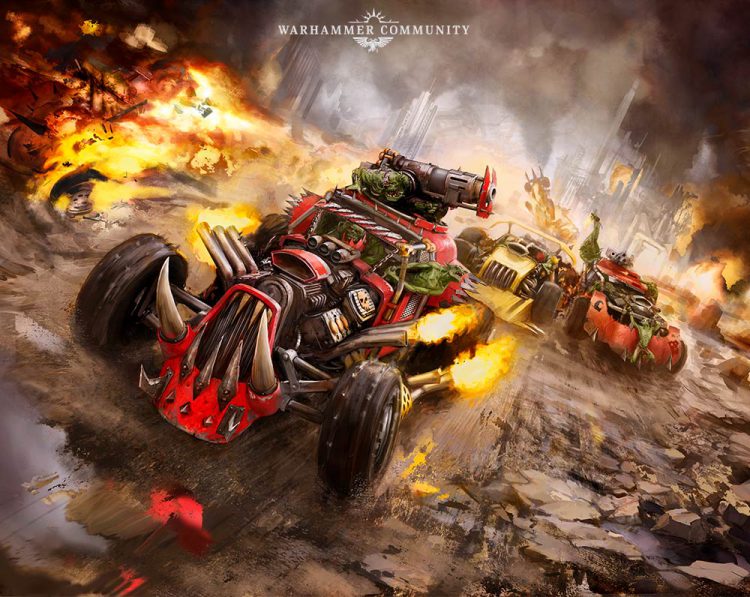
Where to Read More
Orks in 40k tend to get the “antagonist faction” treatment in most books they appear in, making it a bit tougher to find quality fiction that gives them the treatment they deserve.
- Deff Skwadron, by Gordon Rennie and Paul Jeacock, is a graphic novel that follows the exploits of a group of bloodthirsty ork pilots called the Deff Skwadron. It’s tougher to get, but it’s pretty good!
- Dawn of War (and its expansions) and Dawn of War 2 both have campaigns where you can interact with (and play as) the Orks, and they’re fun as hell to play.
- On that note, the Space Marine video game focuses primarily on the titular faction, but it’s still loads of fun and has Ork antagonists. and I am going to plug it every chance I get.
- Prophets of Waaagh! is a new audio drama that takes place after the opening of the Cicatrix Maledictum, following one warband as it fights for survival. It’s pretty good as well, and there’s a new episode coming soon.
- Blood and Thunder is another graphic novel featuring Orks, only this one is written by Dan Abnett. It follows the rise of a new Ork leader waging war on the Imperium.
Playing 40k Orks
Orks in 40k tend to work as massive mobs of boyz who use Weirdboyz Da Jump to hop through the warp and land right on top of the opponent, ready to crush some skulls. They can be supported by a variety of vehicles like Deff Dreads and buggies, or by a fleet of Mek Gunz, ready to blast the opponent into oblivion. We’ve covered the faction in detail in Start Competing: Orks, and we’ll be updating it with the Psychic Awakening content soon.
Kill Team
In Kill Team, Orks are a horde, and tend to bring a large number of cheap models who can hold ground and clog up passageways and control doors in Arena. They tend to do best in missions where the priority is holding ground over body counts. We haven’t written our Kill Team Tactics on Ork kill teams yet, but it’s in the works!
Painting Orks for Warhammer 40k
While Orks in 40k tend to all share the same green skin, the sheer variety of paint schemes and models you can field with them makes them one of the most varied armies in the game. The nature of ork vehicles, which tend to be ramshackle, and looted from other factions’ vehicles, means that they lend themselves to more insane and creative conversions than any other army.
Brin’s Method for Ork Skin
Green skin is not a thing we see much in the real world, especially not on people shaped things, as such if we want to paint our models in green skin tones we have to be fairly creative to make them feel natural especially if we want that green to be bright and easily readable on a tabletop from gaming distances.
First we need to start by deciding on our shadow colour. This colour should have not just contrast of brightness but also of tone and saturation. If we observe where we want to be on the colour wheel and look roughly opposite we can see a good range of colours and tones that we can use to provide that additional contrast.
Directly opposite our greens we have colours like pinks and magentas which might be rather harsh but if we decide to not go directly opposite but bring out colours slightly closer together we can look at purples. Considering we are going for something quite saturated if we go too strong with this colour we might end up having them clash and distract from the green rather than highlighting it. Our eyes rely on context to judge colour, the purple should act to underline the green colour and make it stand out more rather than allowing them to blend together. For this purpose I’ve picked Vallejo Light Purple Brown which is a purple that’s not too saturated and which is dark enough to read as a shadow tone but which isn’t actually as dark as we could go so as to help to elevate the brightness of the model as a whole.
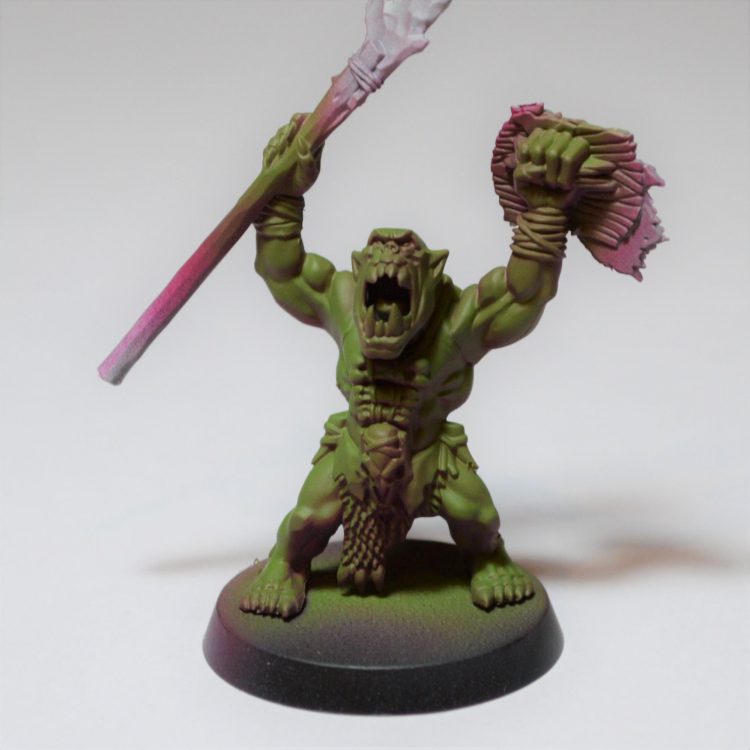
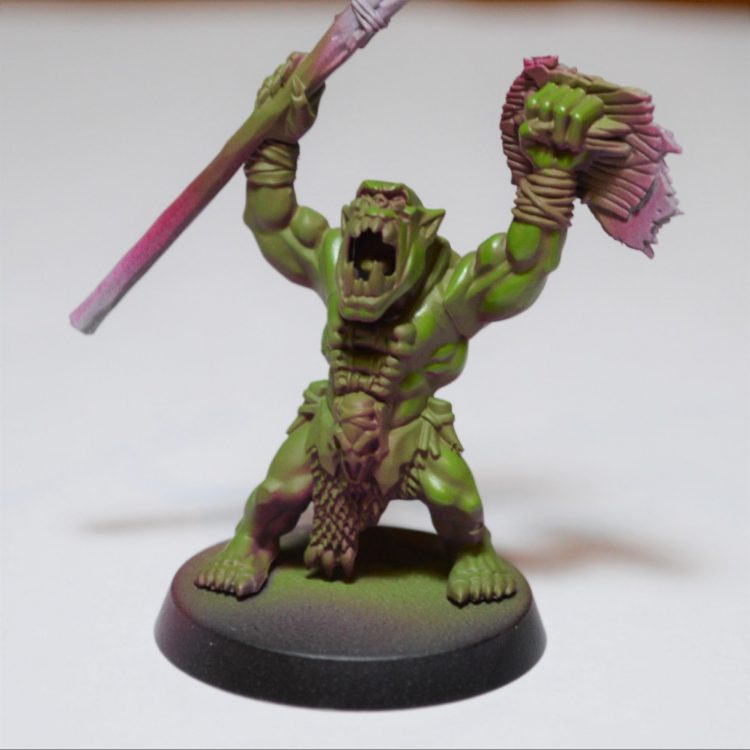
Next we need to decide on a base colour for our green, this base needs to be able to smoothly transition from the purple, as such we want a green that doesn’t immediately overpower the purple and allows us to build against that in the highlights instead. I chose to use Vallejo Goblin Green because it’s a cooler green with a bit of a blue tone that’s not too saturated and can provide a good colour to bridge to where we want to be.
I chose to apply these two colours using my airbrush, applying the green in a Zenithal highlight; this made the green transition from my shadows without much work and allowed me to achieve a nicely blended look, although this would be achievable by hand with some more time spent on this stage. I also did apply a tidy up coat of this green to reinforce this colour, although this wasn’t strictly necessary as the main highlights would do this anyway.
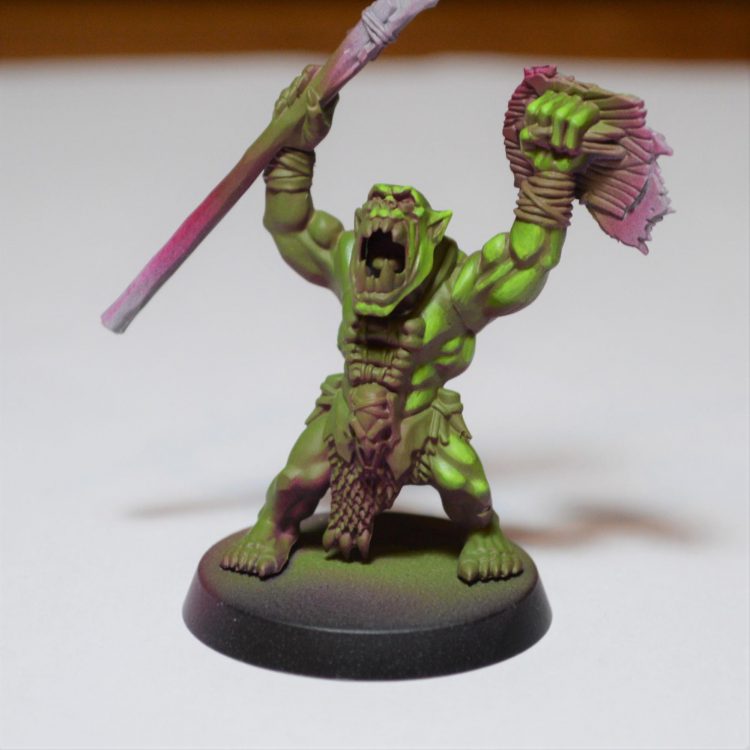
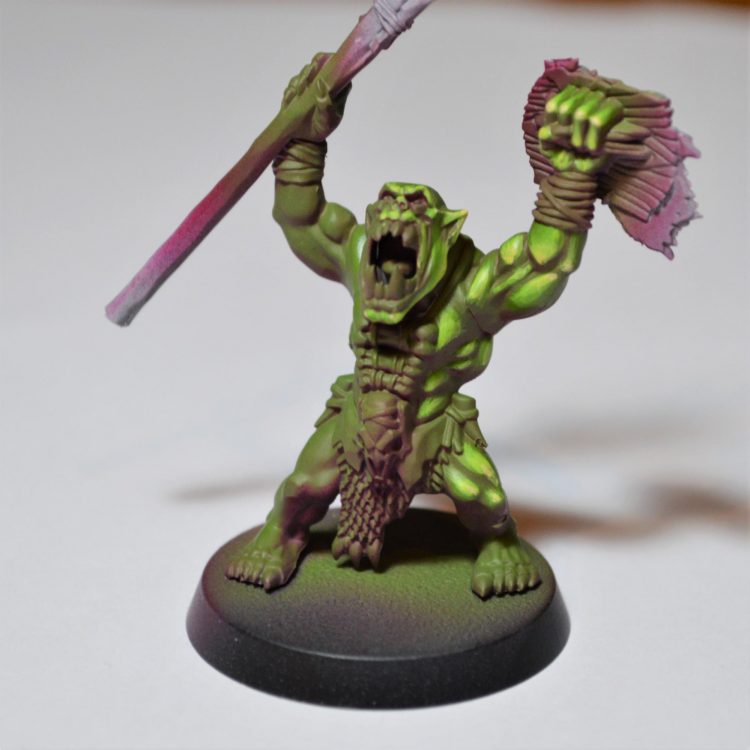
For our main highlight stage I chose to use two green highlights instead of a single stage to aid in repeatability and consistency. We needed two greens which were successively brighter and more yellow toned, I chose to use Vallejo Escorpina Green and Vallejo Livery Green. Applied with a focus on where light would hit but also on reinforcing the muscle definition and enhancing that contrast that we’ve been striving for.
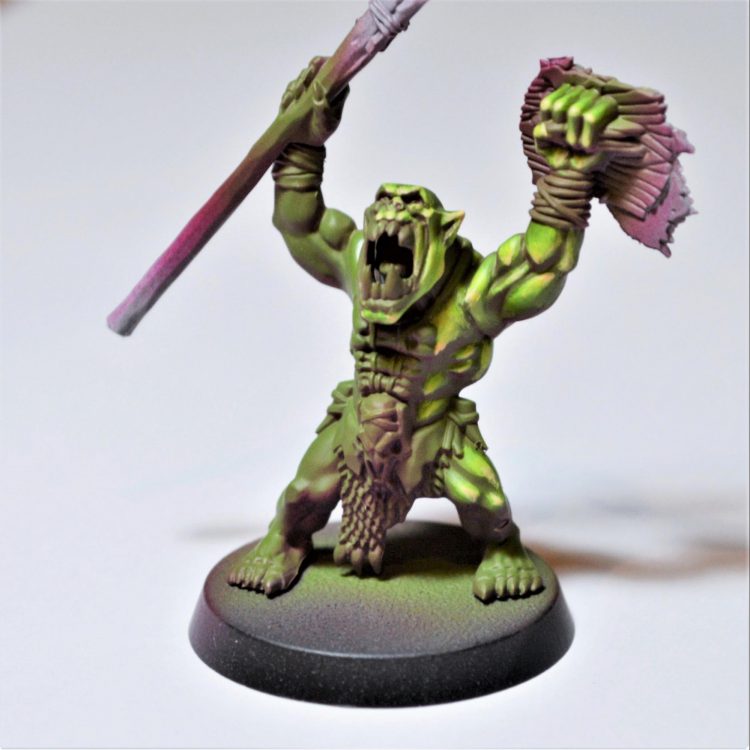
We’ve now got a very strong green but we want a final highlight to aid in readability and to push us more towards a skin like feeling, using a bright pale skin tone allows us to push in that direction and has the added benefit of adding even more warmth to our final colour. I used Vallejo Cadmium Skin as this is my standard final skin highlight colour.
Alternatively we might choose to use a yellow such as Vallejo Gold Yellow for this final step if we want our colour to be very brightly green and not this final slightly softened colour, for instance for goblins instead.

Once this is all done some of these steps might be a bit messy or harsh and by gently mixing and blending our colours we can tidy these up and soften any transitions that are too strong to read as natural.
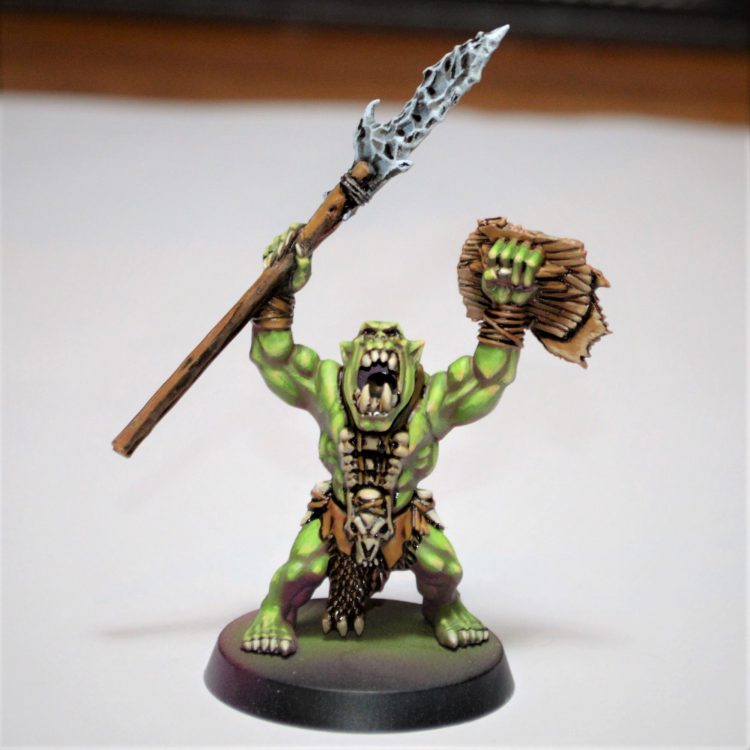
And then presto, it’s Orky!
After this all you gotta do is paint all his friends.

Greg “Greggles” Hess’ Method for Vehicles
You can follow Greggles on Twitter: @3dgreg
Hey everyone, I was asked quite politely to write a Goonhammer article on how I paint my Deathskulls vehicles. The technique I use is similar to the hairspray and salt weathering techniques, but combines a few others to heighten the effect. It’s a relatively easy technique, but requires that you…
- Have patience
- Be Random
- Have a really messed up brush
- Have or “borrow” an airbrush
- Possibly have a tooth brush that you “rented”
- Be willing to do all the armor on a vehicle (or unit) at once, so it looks consistent.
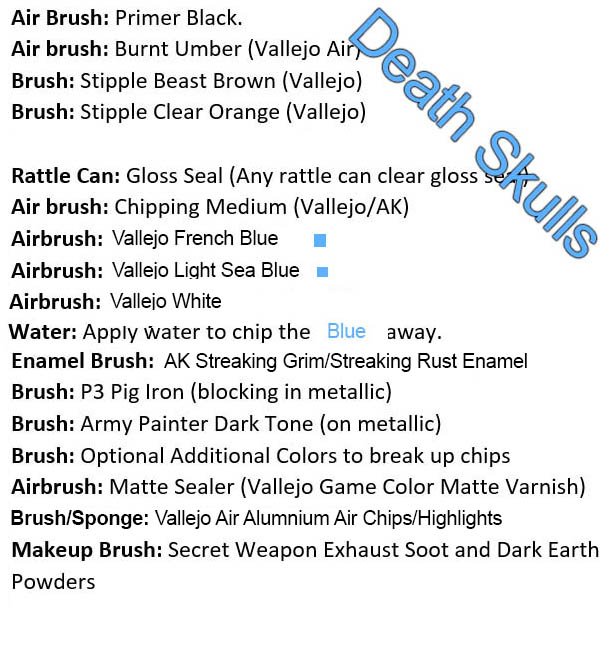
(Side Note: This technique is an amalgam of many artists and techniques. I’ve had the pleasure of meeting and learning from many great artists, such as Dave Taylor, Dave Pauwels, Marc Raley, Damon Drescher, Misterjustin, Jeff Jenkins, Joe Johnson, and many others. They have all influenced this technique, and I take from many of their ideas to produce this step by step)
This technique will produce a cool looking effect, followed by an effect you don’t really like, followed by an end result that looks freaking cool. You have to be prepared to feel like you messed up, and still power through to the end. In this example, I’ll be doing two stompa shoulder armor plates to show how different it can turn out on exactly the same piece of kit, and exactly the same technique (even done simultaneously). I recommend duplicating armor plates if this is your first time (I do this almost every time I use this technique, so I can pick my favorite to use)
Step 1: Priming
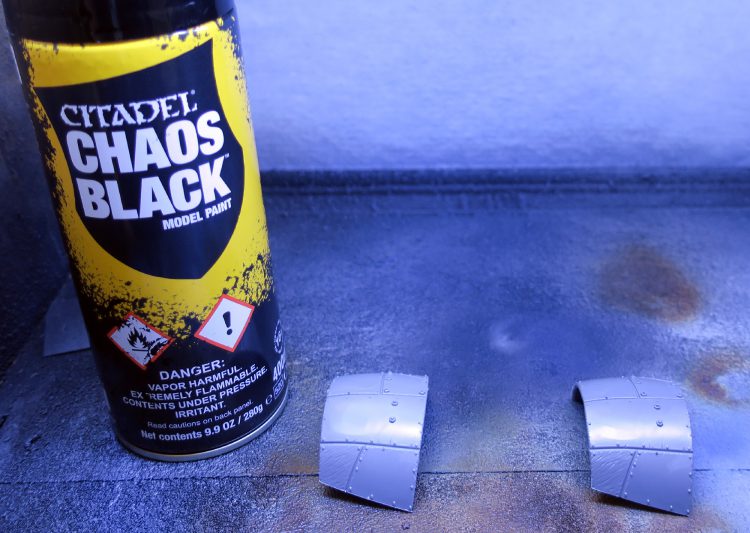
Prime your model in black (Editor’s Note: Damn straight), preferably with a spray can (not airbrush) primer. I prefer to use Chaos Black from GW for this (I generally just use their primer for vehicles) because it is rather stout and thick.
I avoid airbrush primers (which I tend to use for everything else) because they go on very thinly, and are easily torn off through the techniques we will be using in this tutorial.
Step 2: Rust Base Coat
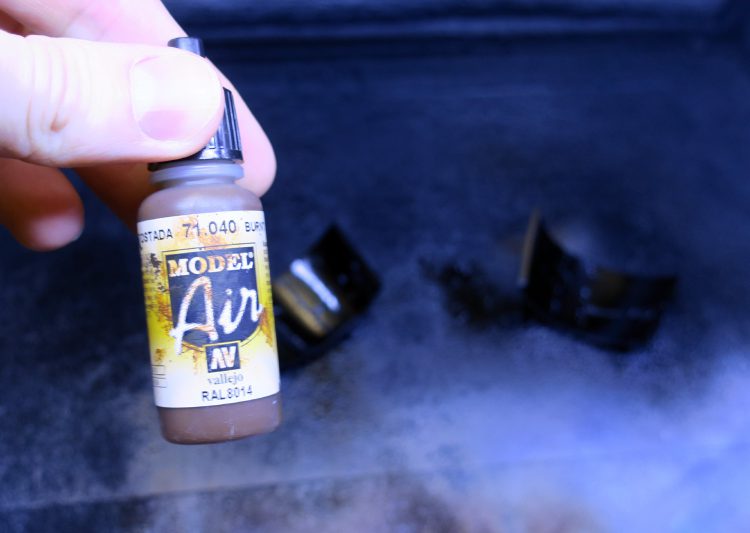
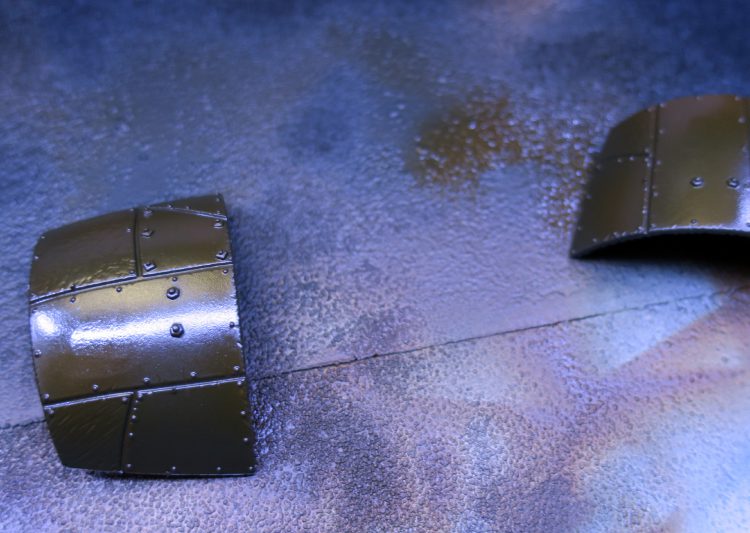
Base coat the armor plates in vallejo air BURNT UMBER. This is a lovely base color which gives us our dark chips. Make sure to get all the sides.
Step 3: Stipple Light Brown
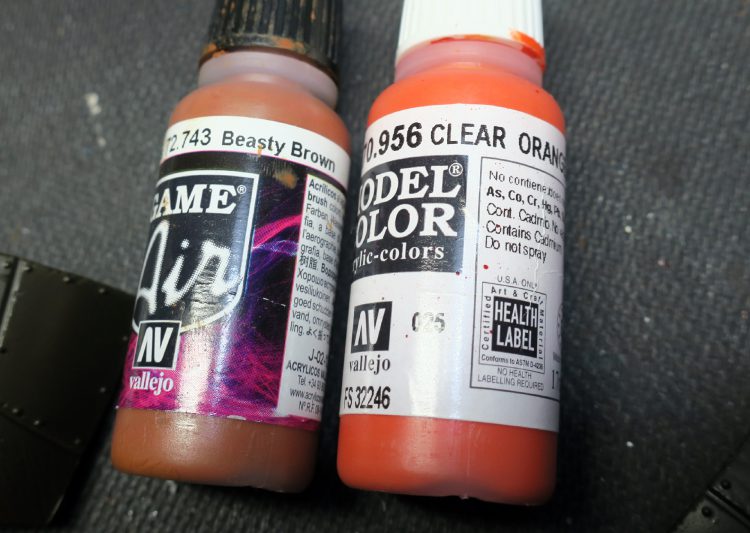
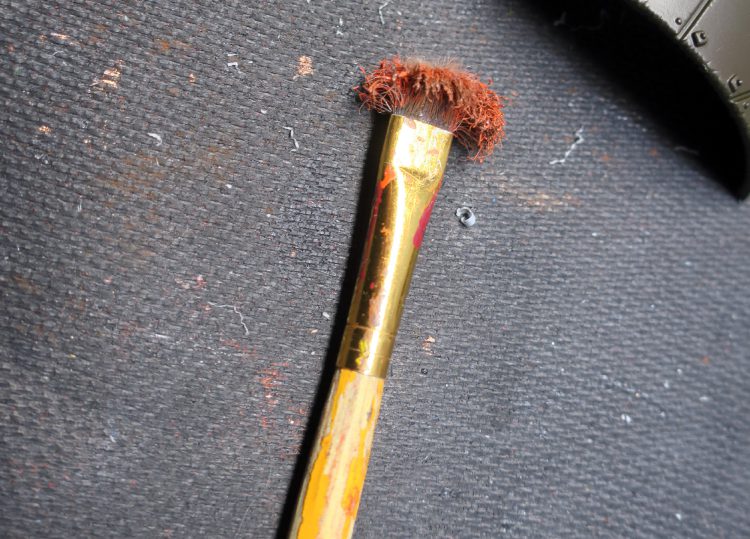
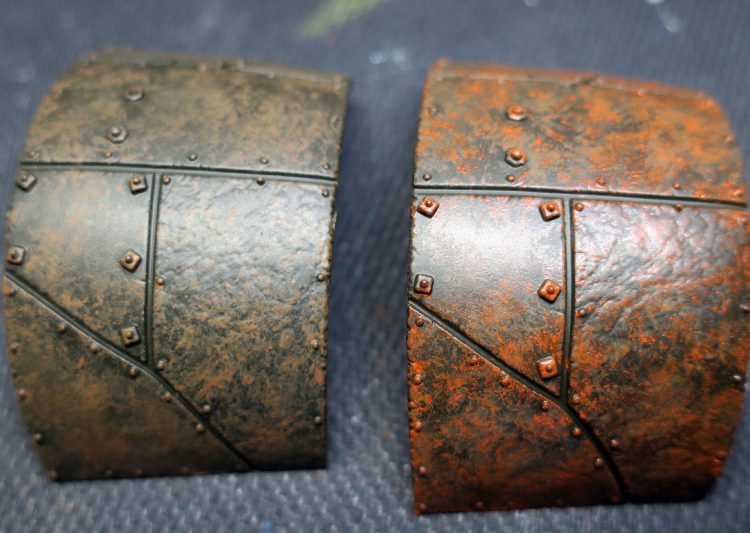
Get a really crappy brush…i mean seriously crappy. You can see my magical weathering brush photo’d here. It’s an absolute mess. I have no idea how it got this way, but it’s so perfect for this technique. Using BEASTLY BROWN, dip the brush in the paint, and wipe off the excess. Then stipple the paint onto the armor. I like to wear gloves during this, as I can use my fingers to adjust the paint if I get it on too thick in one spot, and this just heightens the effect. Let the paint dry before the next step.
Step 4: Stipple Clear Orange
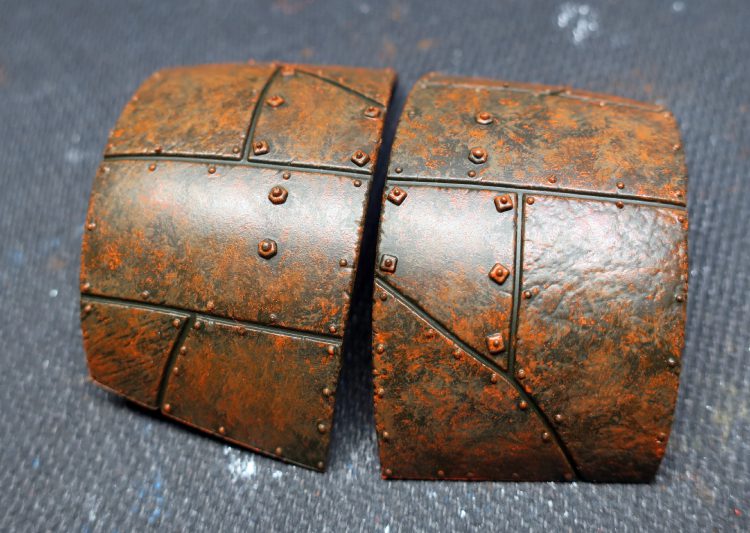
We are now going to stipple another color onto the armor. This time CLEAR ORANGE. This is a VERY bright color, that dries with some transparency to it. You want to make sure there isn’t much left on the brush when you begin stippling, as you want less orange then beastly brown put on. Use your gloved hands to blend in any excess. Wait again for it to dry.
Step 5: Varnish Layer
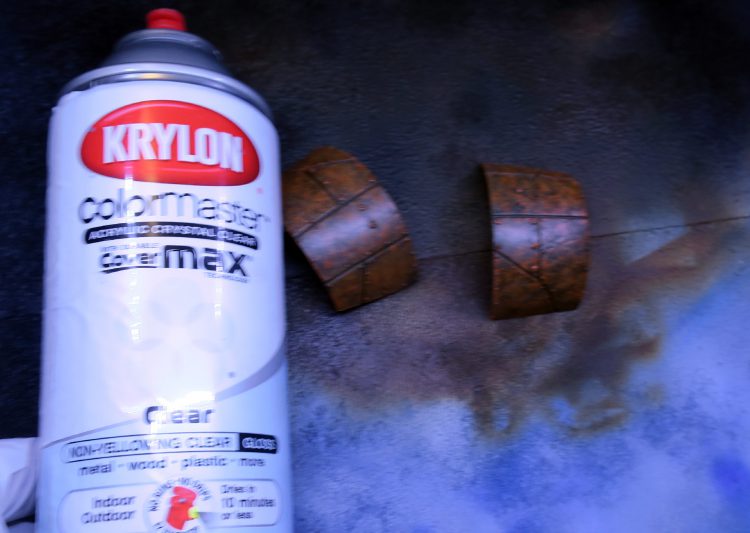
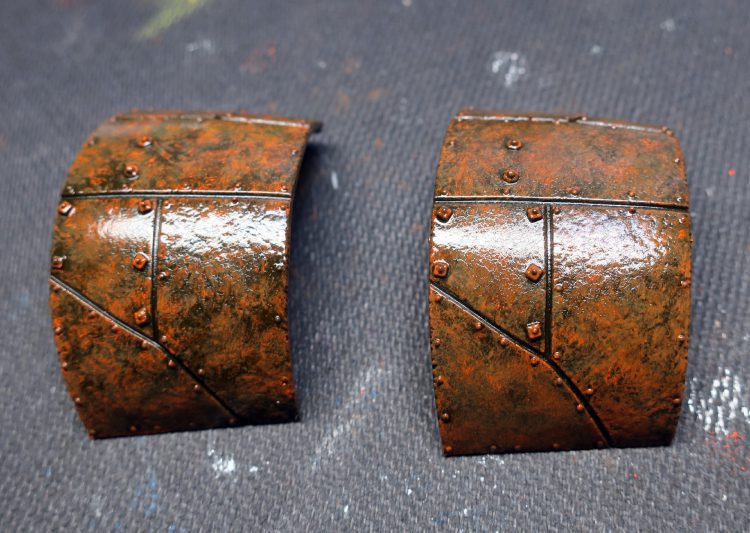
Now we are going to varnish the armor plates. I like to use a gloss varnish from a rattle can for this, because once again, we are going for durability over quality. The varnish will protect the rust layers (that you spent so long building up) from the scratching and ripping we’ll do in the next steps. I let the varnished models sit over night and save the chipping steps for when I have a lot of time. (as generally I do all the armor on a unit or model at once).
Step 6: Chipping fluid
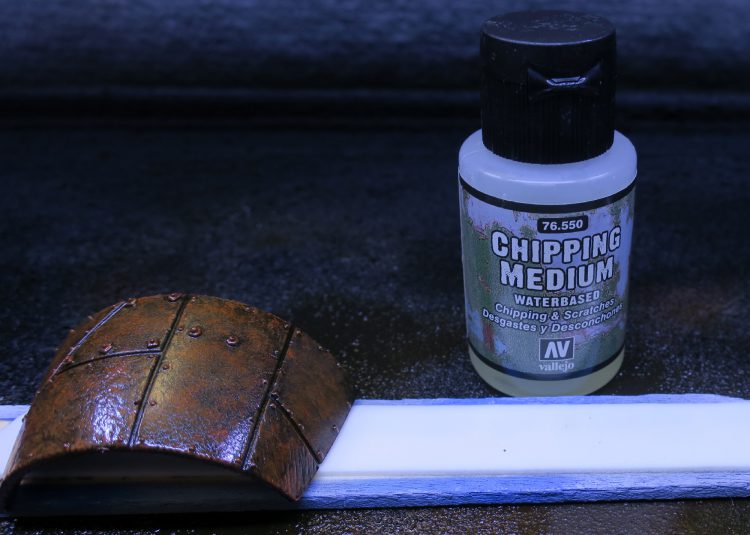

Now begins the fun part. I use vallejo chipping fluid through the airbrush on the armor. I coat the armor in thin passes until I see tiny beads form on the armor. (See photos). This is actually the wrong way to use it. You are supposed to do light coats in multiple passes. Depending on the effect you want, you can combine techniques, super saturate it on, or whatever you want! At this point I leave the plates to dry for about an hour, then attach them to a spraying stick for the top coats of paint
Step 7: Top coats
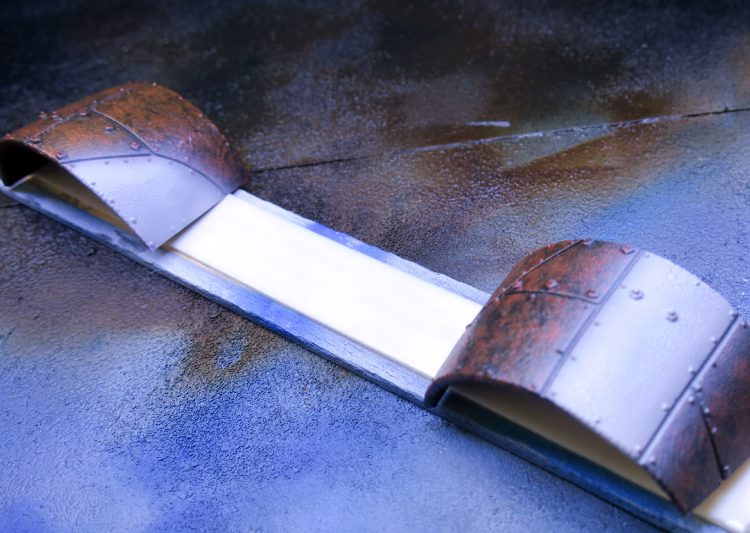
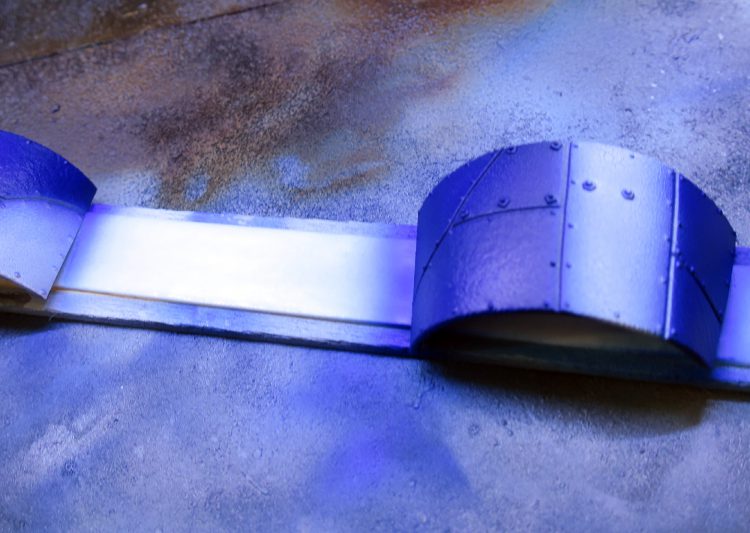
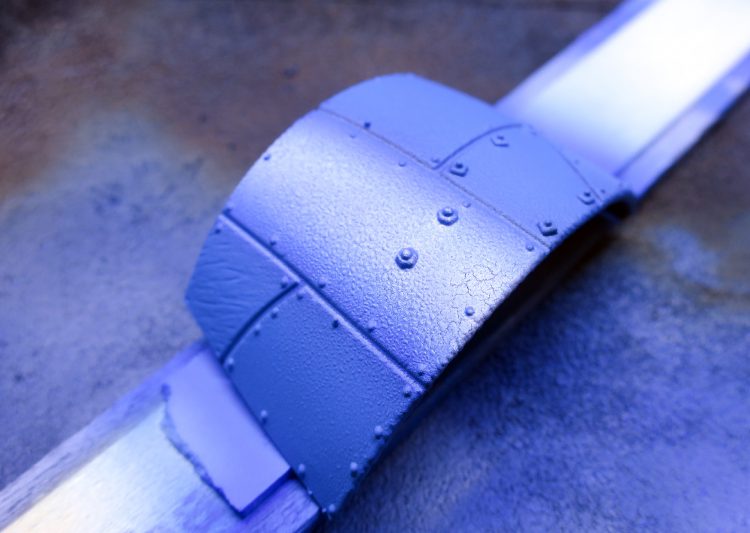
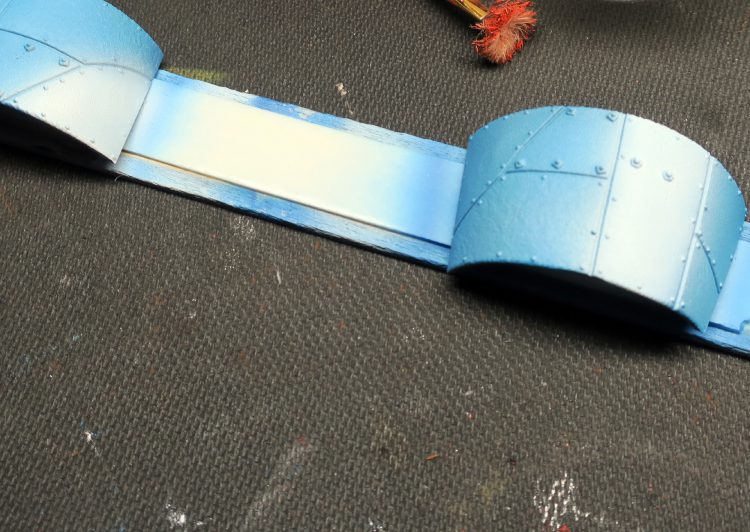
Now it’s time to actually put color on the armor. I use the following paints for my Deathskulls recipe: Vallejo french blue, vallejo light sea blue, and vallejo white. (All air colors). You can use whatever colors you want at this step, just make sure they contrast well with the rust tones you have been painting. (Don’t use reds, if you want to do reds, you need to integrate more purple tones into the rust underlayer).
I apply the white first, then hit up with a french blue coat, followed by a sea blue, followed by a bit of white (from above to give some tonal variance). It doesn’t really matter too much if you bleed one color into the next. The chipping takes care of it. This is a messy process, and sometimes “happy little accidents” make the end product even better. Any bleed or cross over here will just create some tonal variance in the end product.
Step 8: Chipping!

This is the part you’ve been waiting for. All the work leads up to this step. We now take the armor plates and run them under water, then use a variety of tools to physically remove the outer layer of paint. Be careful around the white, as it is usually just one layer, and can easily flake off.
Step 9: Enamels
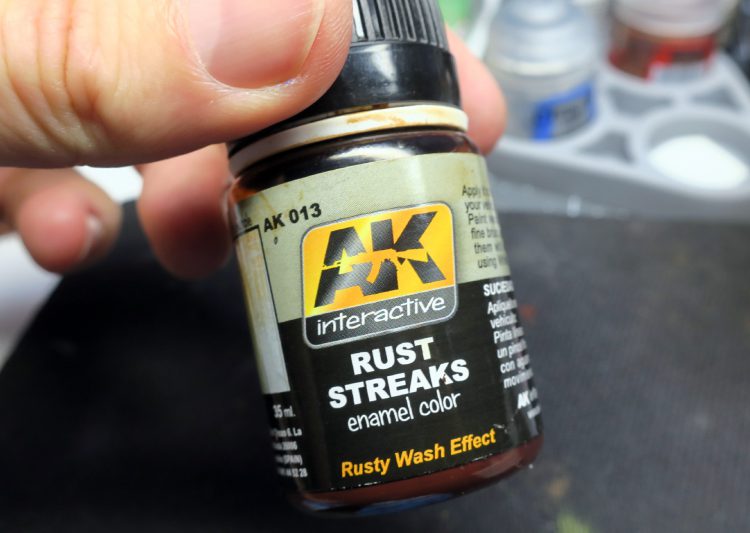
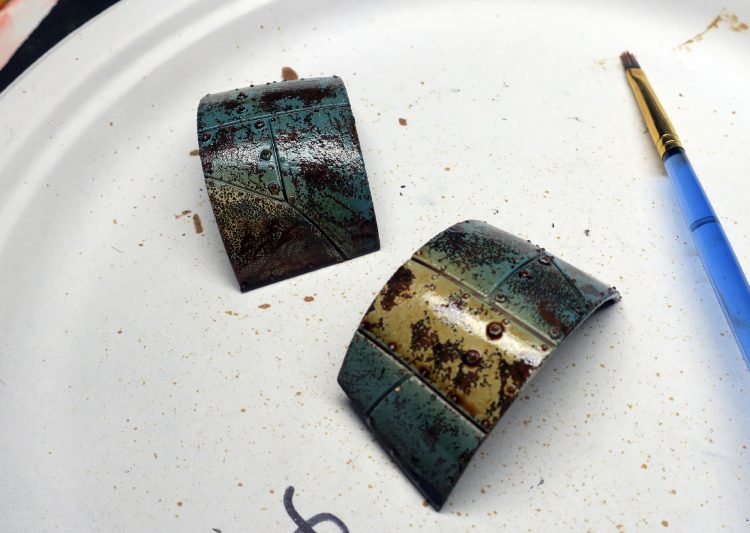
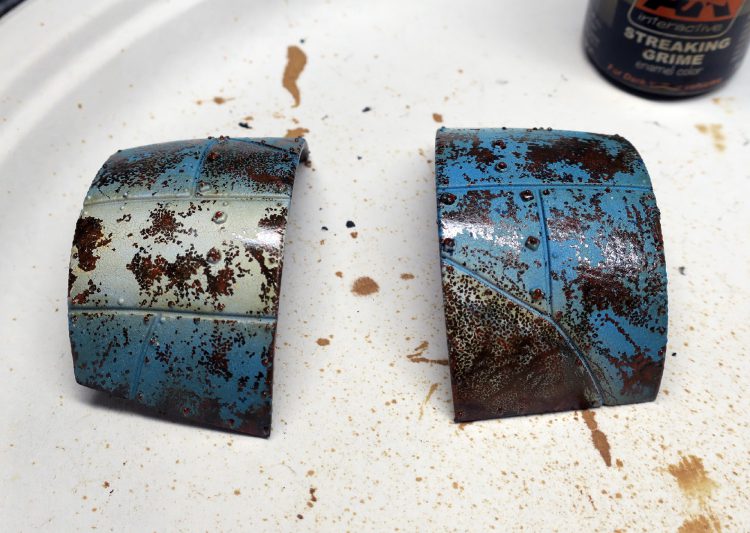
At this stage I pull out some AK Weathering enamels (rust streaks) and apply them over the model to add contrast to the chips. This also dyes the blue to match the rest of my armor (which is kinda of a turquoise blue). You can use other washes (oils are great) to get the same effect. I use enamels/oils over acrylic washes because I can use white spirits to blend and remove excess amounts of the wash, and play with the surfaces to get tonal variances to add interest in the armor plates. When doing either oil or enamels, make sure to give it significant time to dry before proceeding.
Step 9a: Metallics (Optional)
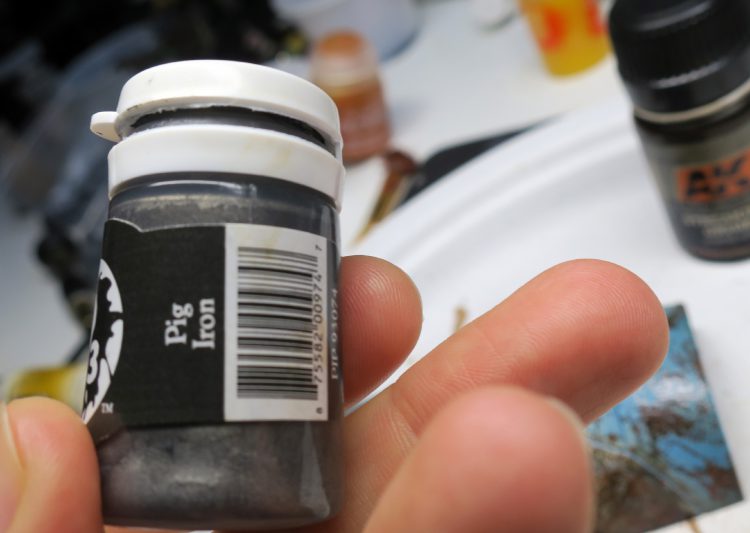
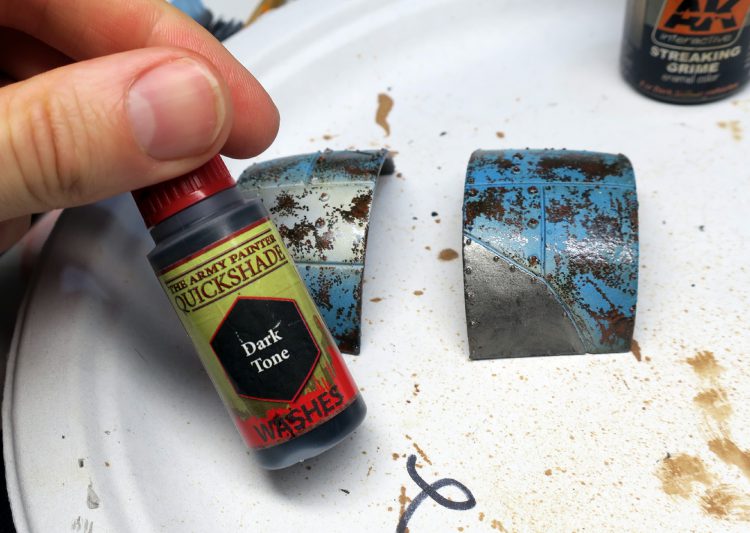
On my orks in particular, I like to swap some of the armor pieces with fresh replacement metal, as if the orks had to weld or bolt a new plate on, because the other one rusted off too much. It also helps break up the surfaces (and also covers up a bad chipping job, which can happen, cause it’s random). For this I just use P3 Pig iron, then follow up with some Army painter Dark tone as a wash.
Step 10: Matte Varnish
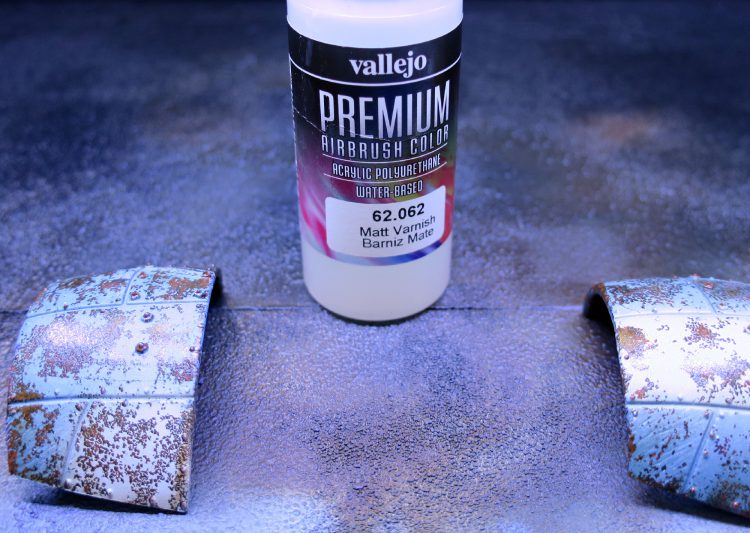
This is the magical step, where everything comes together. I use Vallejo Premium Game Color Matte Varnish for this. Just apply with the airbrush, and enjoy the results. It’s magical. I usually have glued all the armor plates on the model at this point, so that the final steps (metallic chips and weathering powders) reflect where the armor plates sit on the model more realistically.
Step 11: Final Metallic Chips
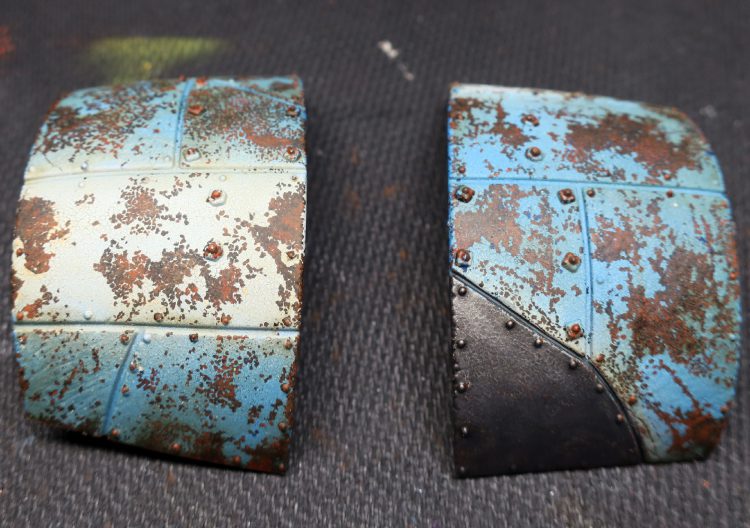

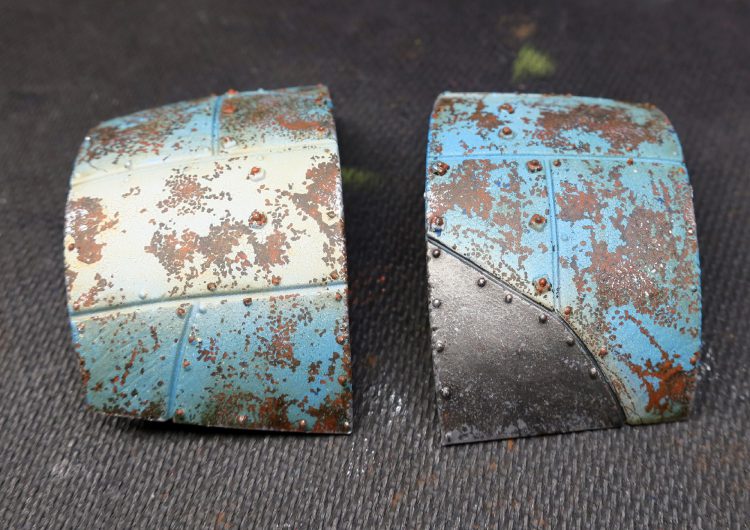
After the varnish has dried, I come back with a sponge with vallejo aluminum air, and chip the edges and some of the larger chips to indicate where fresh metal has been exposed. Adds another layer of variety and interest to the model, and really catches the eye in person.
Step 12: Weathering Powders
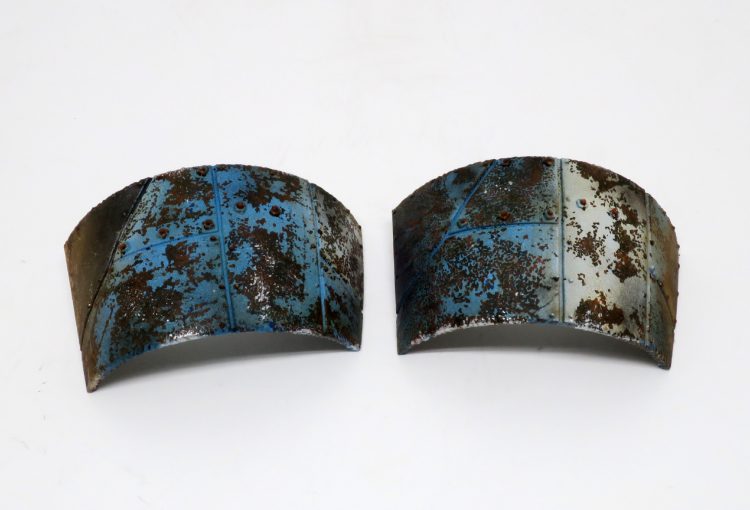
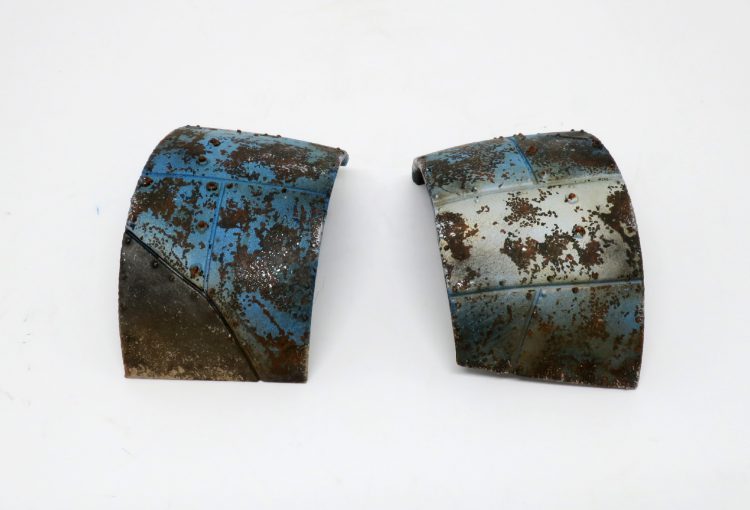
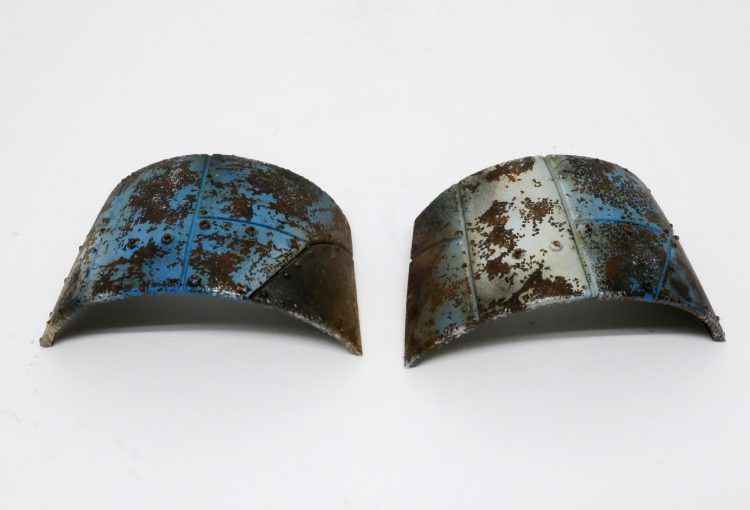

Depending on the placement of the armor plate on the model, I’ll apply a bit of weathering powder as a final step. I use secret weapon powders for this, and match the powder to the effect I’m looking for. (dark earth for dusty ground, black soot for exhaust/guns).
At this point you should have a result that looks weathered and worn and downright grimmy. One thing to be careful of when painting armor this way, is to make sure you have strong contrast on other parts of the model. If you paint the entire model this way, it loses its impact (like a rust camouflage). This is one of the reasons most of my models have a very clean looking under skeleton by comparison to the armor plates. I originally tried doing it all over the model, and ended up with (and I quote) an army of banana orks.
This technique is very repeatable, but I do recommend doing all the armor on a model, or a unit of models (such as three deff dreads) at the same time. This will keep the color variance similar and make everyone look like they belong together. I hope you enjoyed this tutorial, and if you have any questions, I’m always available on twitter under the handle @3dgreg or instagram as waaaghgreggles. Below are a few shots of some of my models showcasing the technique. Thanks for reading and may your models always come out better than expected!
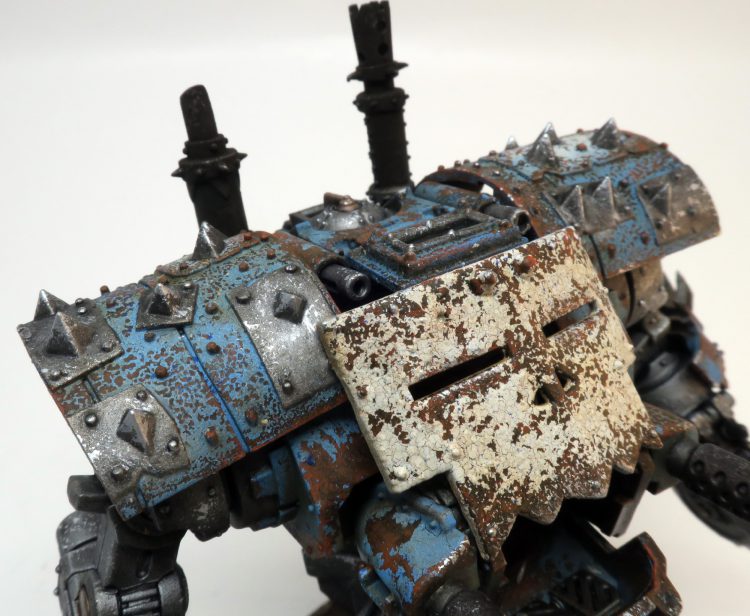
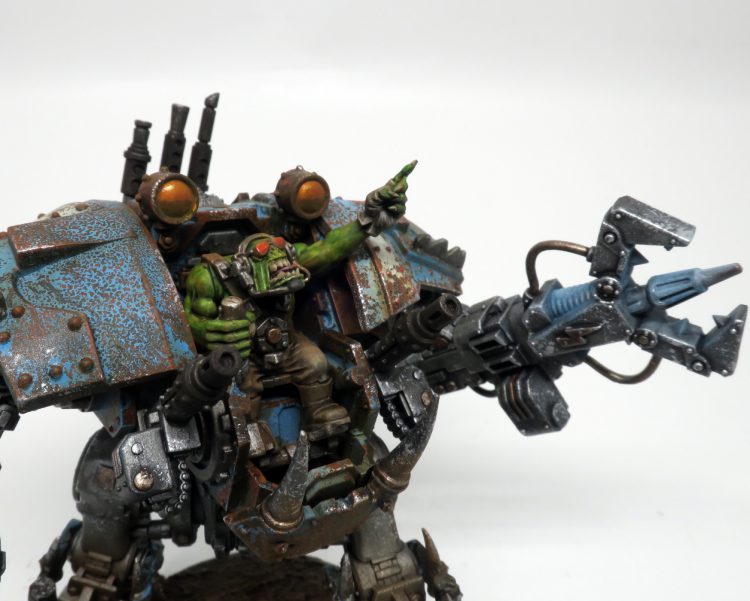

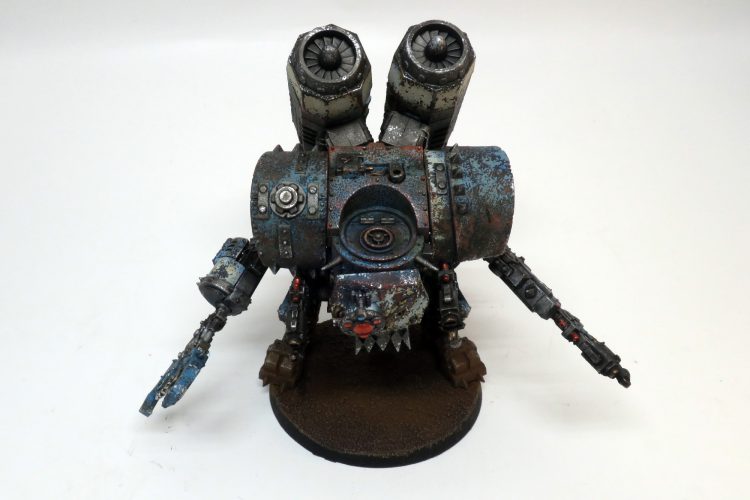
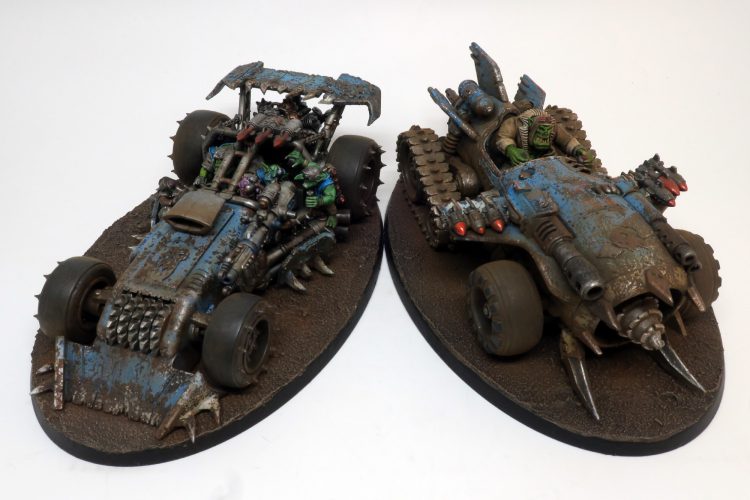
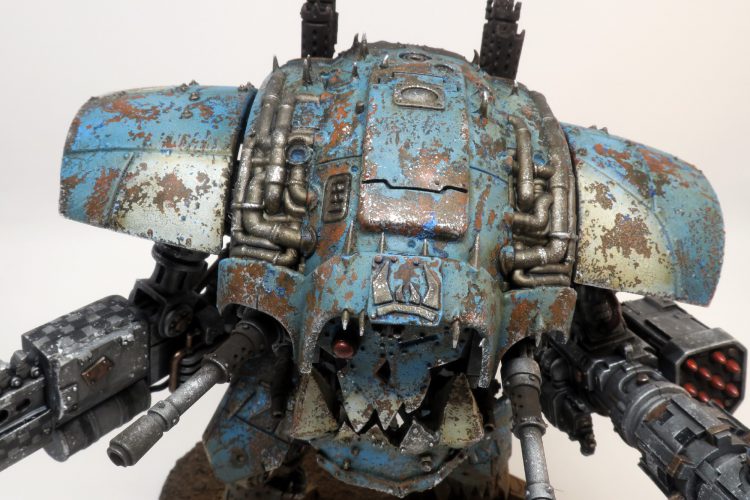
R0ckfish’s Method
With the pandemic arriving and the preview of Saga of the Beast, I went looking under my bed to see if I had any ork kits to work on. Unfortunately previous me did not form a backlog beyond a painboy. Which was a bit disappointing but hey, I did not have any painboys otherwise and it means I have no backlog for one of my armies! This is going to be based on my second round of painting orks that simplified the scheme a bit, which given how many paints remain is saying something! Rather than step through each colour, I am mostly going to leave that to the pictures and describe ambiguity instead.
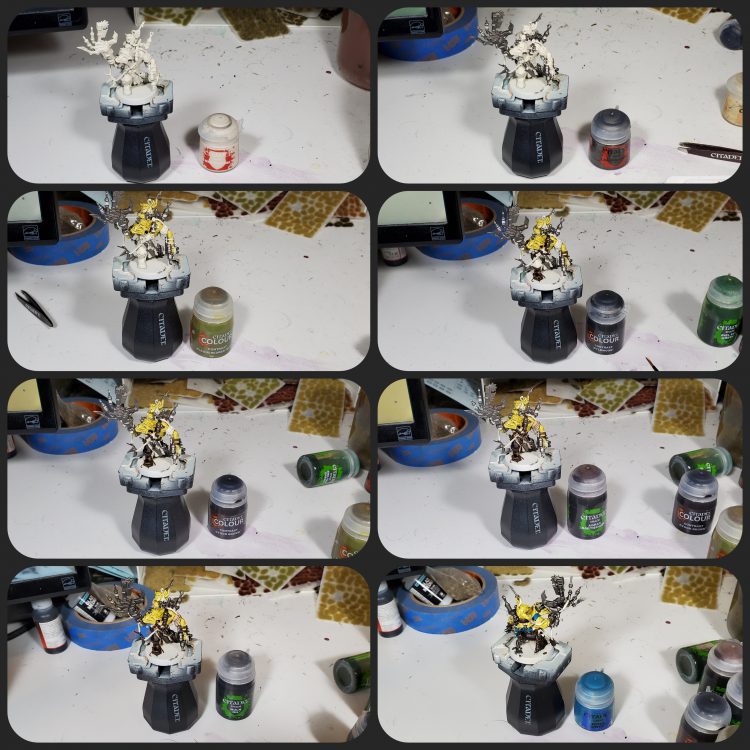
The plaguebearer flesh takes over the role of my previous mix of skarsnik and averland quite well, it is still a bit blotchy but most of that gets hidden. If you want to have smoother tones, you can replace the plaguebearer with a 2:3 mix of averland and skarsnik.
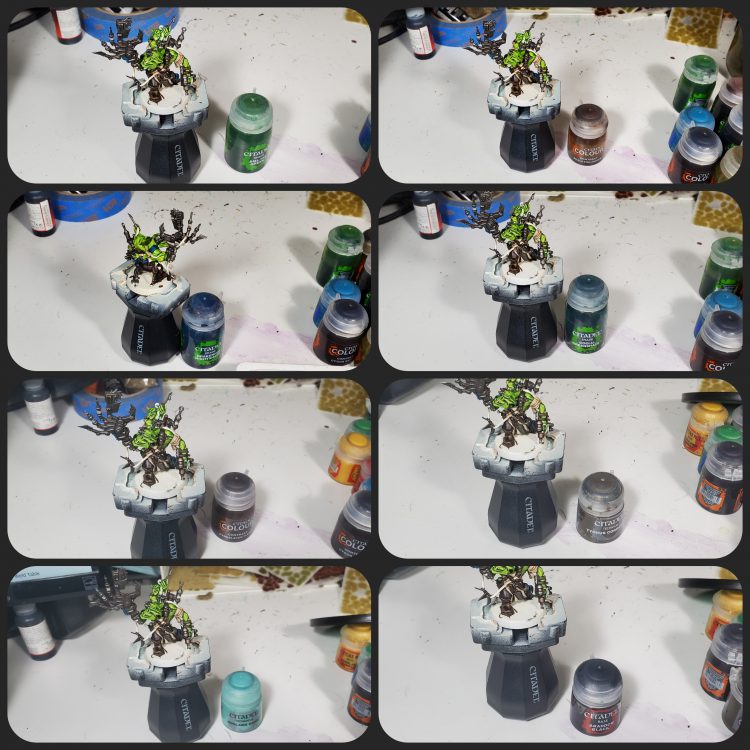
Biel-tan green over a yellow-ish green ends up with a fantastic skin tone for orks in my opinion, you might get away with leaving the skin here for a horde of boys but I am a masochist and like pale orks so we will revisit the skin later
Fyreslayer of nuln-oiled leadbelcher is a fantastic way to make really lazy copper, brass can be done in the same way with snakebite leather! For the typhus I mainly target moving joints, large bolts and such. Similarly when I want verdigris with niklilath oxide I target it to random dimples, rivets, and low down corners.
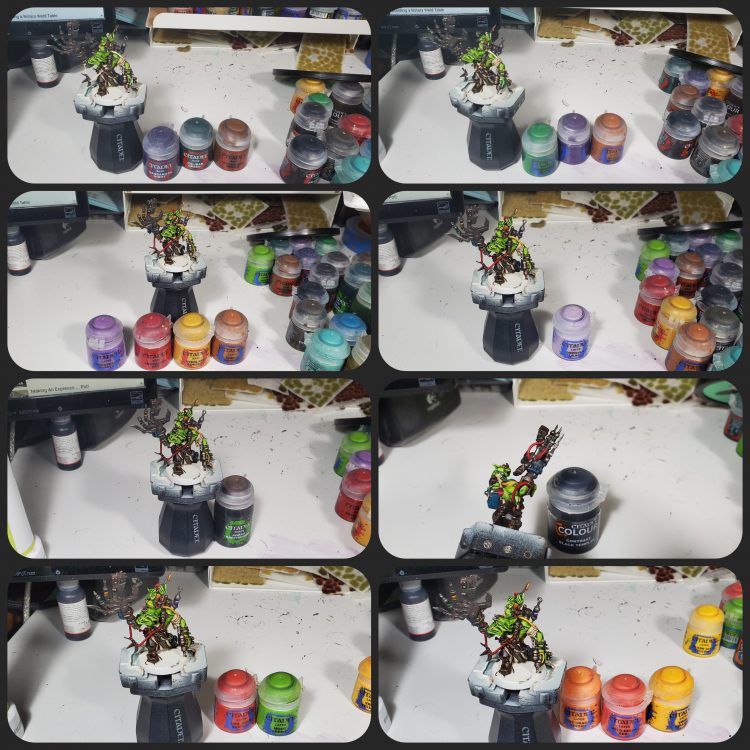
I forgot to take a picture of it, but the switch between skrag and averland was a bit too obvious, so I toned it down by going in between with a 1:1 mix of the two. I also managed to get one of the paints hidden, that one is xereus purple.
My checkering is super lazy since I am just doing orks. If you want a better example check out our How to Paint Everything on checks, hazard stripes, and other details.
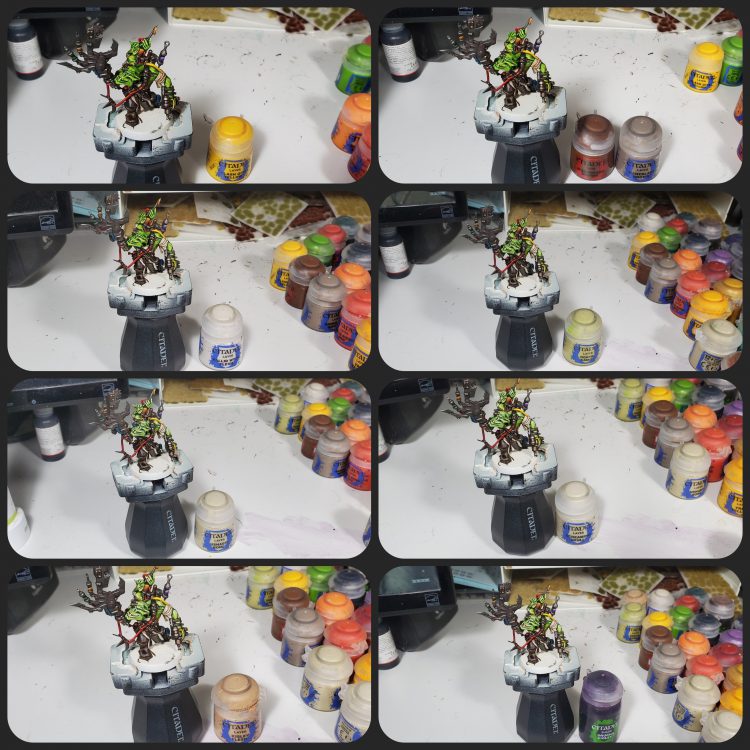
When applying the Ushabti I like doing little chevrons pointing to the top of the muscle, it gives the implication of it being a shaped mass without proper blending. The screaming skull was just used on the teeth.
These days when I highlight metal I almost exclusively use Stormhost silver, it does not necessarily look accurate, but it pops sooooo nicely.
The Kislev I mainly focus on things like knuckles, scars, and tips of noses/ears to give them a bit more pop, I then use the Druchii on lips to give them a denser colour.
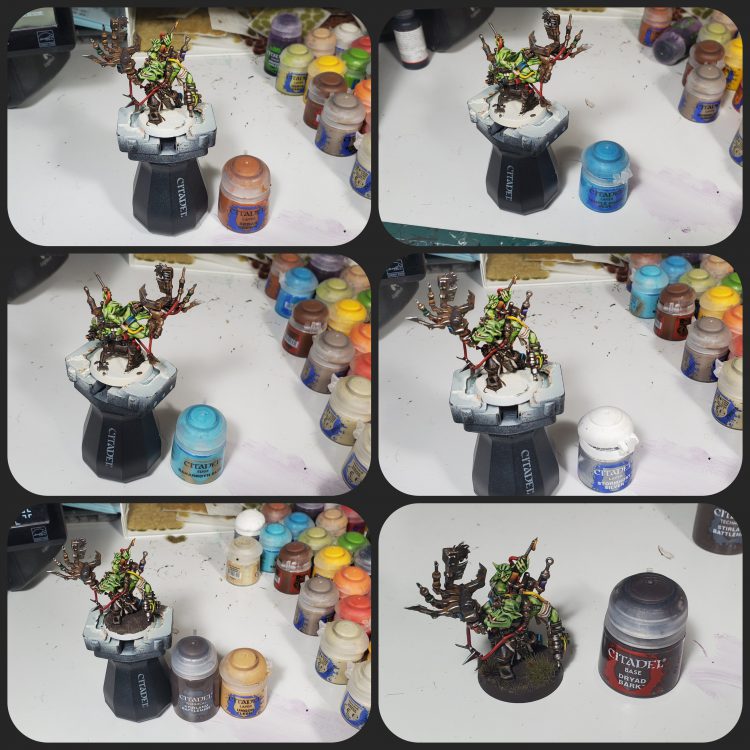
For rust I like using watered down skrag, no need to get fancy when thinning it either just plan water is fine. I usually push the rust towards the bottom of areas to help create a gradient and make the clean areas really pop.
For bushes I use Gamer’s Grass, they have been consistently durable and good looking so I have most of their range at this point.
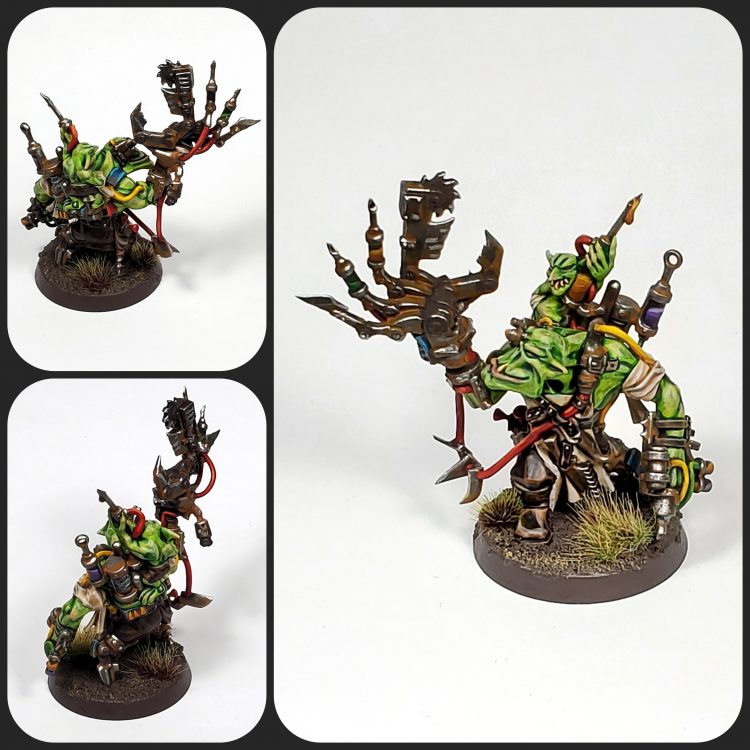
“Primaris” Kevin Genson’s Method
My Orks were painted over a decade ago so unfortunately the colors are about two or three generations old in terms of Games Workshop paints. Nowadays I would almost certainly replace a lot of the work with a few layers of Contrast with some highlights added. Some of the paint colors can be roughly translated here; I recommend looking at the Vallejo Game Color line. For the inks I suggest looking at Liquitex Ink! which is available at many hobby stores, and for the washes I highly recommend the Army Painter wash line. Instead of Future Floor Wax you can use a thinning medium like Vallejo Flow Improver.

Skin
- Base coat with Knarloc Green (could use Army Painter Greenskin spray)
- Coat with Snot Green
- Highlight with Goblin Green
- Highlight with Goblin/Scorpion Green (50/50)
- Wash with Thraka Green
- Line the crevices with a mix of Dark Green Ink and Future Floor Wax
Metal
- Base coat with mix of Boltgun Metal, Solar Macharius Orange, and black to create a muted, rusty color.
- Highlight with Boltgun Metal
- Wash with Badab Black
- Wash with Gryphonne Sepia
Clothing
- Base coat with black
- Light drybrush of dark gray
Leather
- Base coat with Bestial Brown
- Highlight with Vermin Brown
- Wash with Gryphonne Sepia
- Line shadows with Brown Ink
Teeth
- Ink shadows with Chestnut Ink
- Base coat with Tallarn Flesh
- Coat with Bleached Bone
- Wash with Gryphonne Sepia
- Highlight with Bleached Bone
- Apply Chestnut Ink to base of teeth

Base
To make the base, start with drywall putty to create a mud pattern. Apply dots and splotches of PVA glue and then dump sand and small rocks over it. Once the PVA has dried, wash the whole thing with a layer of thinned down PVA to seal it all in.
- Base coat with Calthan Brown
- Coat with Bestial Brown
- Drybrush with Vermin Brown, Solar Macharius Orange, and Snakebite Leather
- Apply a thick wash of Devlan Mud
- Ring base with Scorched Brown
Finishing Touches
- Spray with matte varnish
- Line crevices of flesh with straight Future Floor Wax
- Coat top of base with Future Floor Wax
FlamingFig’s Method
When I was young my first introduction to orks was the old dawn of war games, more specifically Dark Crusade which I still to this day play for one reason and one reason only: The orks. Especially Warboss Goregutz ‘Eadtakea, my personal favorite warboss to this day. When I was playing the game I absolutely fell in love with the orks from Warhammer. The fact that these are a bunch of barbaric space aliens that work much like a mad max highway road warrior post apocalyptic clan is fantastic. They have the logic of them to boot when it comes to their weapons, iconography, armor, and everything! Every other faction in Warhammer is always boasting or brooding on about their cause and why they need to fight. Eldar brood on about how they want their race to be great again, the Imperium wants to kill everything that’s not them, and chaos is a bunch of edge lords. But the orks!? NOPE! they fight for fighting sake and to snatch some good loot and that’s all that’s need. The universe is their playground and they don’t have a care in this apocalyptic universe and I love that about them.
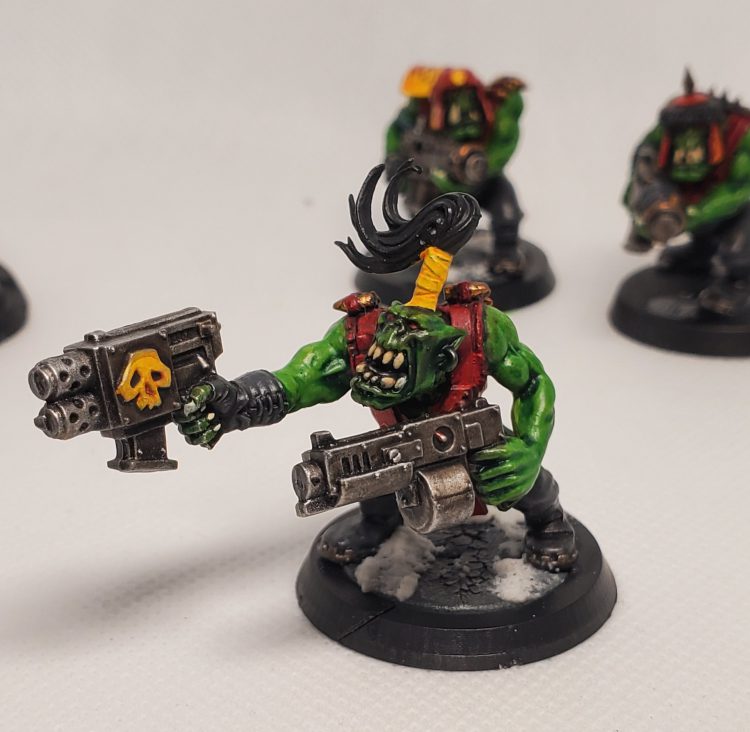
Orks is Da Best
As the old adage goes, “Orks is da best, cause Orks is never beaten.” Strong words to live by. As always, if you have any questions or feedback, drop us a note in the comments below or email us at contact@goonhammer.com.



